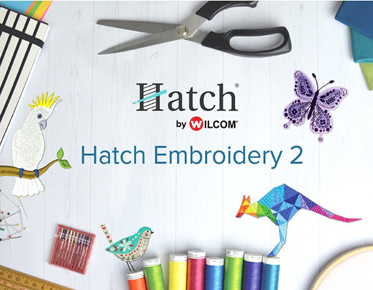AI Revolution: The Role in Modern Embroidery Digitizing Software
In the ever-evolving landscape of technology, artificial intelligence (AI) is making significant strides across various industries. Embroidery digitizing, a field traditionally grounded in manual craftsmanship, is no exception. By integrating AI into digitizing software, the embroidery industry is experiencing a transformative shift. This blend of technology and artistry is streamlining processes, enhancing creativity, and redefining the possibilities of design.
The Rise of Artificial Intelligence in Design
What is Artificial Intelligence? Basic Concepts and Definitions
Artificial intelligence refers to the simulation of human intelligence in machines programmed to think and learn. AI systems use algorithms and data to perform tasks that typically require human cognition, such as problem-solving, pattern recognition, and decision-making. In design, AI enhances creativity by analyzing vast amounts of data to generate insights and suggestions.
How AI is Transforming Various Creative Fields
AI's influence spans numerous creative fields, from music composition to graphic design. In each domain, AI tools are used to automate repetitive tasks, provide design recommendations, and enhance creative processes. By analyzing trends and preferences, AI offers new ways to innovate and push the boundaries of traditional design.
The Integration of AI into Software Tools: An Overview
Integrating AI into software tools involves embedding machine learning algorithms and data analytics capabilities into existing applications. For embroidery digitizing, this means incorporating AI features that assist in pattern creation, image recognition, and process automation. These advancements streamline workflows and enhance the overall efficiency of design processes.
AI-Powered Design Assistance
Automated Pattern Creation: How AI Generates Designs
AI can generate embroidery patterns by analyzing existing designs and user inputs. Using algorithms, AI identifies design elements, suggests modifications, and creates new patterns that align with specified parameters. This automation reduces manual design work and accelerates the creative process.
Intelligent Design Suggestions: Enhancing Creativity with AI
AI provides design suggestions based on patterns, trends, and user preferences. By analyzing a vast database of design elements and styles, AI can offer tailored recommendations that enhance creativity. This feature helps designers explore new ideas and refine their concepts with minimal effort.
AI in Pattern Refinement: Improving Accuracy and Detail
AI tools enhance pattern refinement by analyzing and adjusting stitch paths, densities, and alignments. Machine learning algorithms can identify potential issues in the design and suggest improvements, resulting in higher accuracy and detail in the final embroidery.
Enhancing User Experience with AI
Simplified User Interfaces: Making Complex Design Tasks Easier
AI contributes to user-friendly interfaces by simplifying complex design tasks. Intuitive dashboards, guided workflows, and automated features make it easier for users to navigate the software and execute design functions. This accessibility ensures that both novice and experienced designers can efficiently use digitizing tools.
Real-Time Feedback and Adjustments: AI's Role in Instant Corrections
AI provides real-time feedback during the design process, offering instant corrections and adjustments. This feature helps users quickly identify and rectify errors, ensuring that designs meet quality standards before production begins. Immediate feedback enhances overall design accuracy and reduces the risk of costly mistakes.
Customization and Personalization: Tailoring Designs with AI Assistance
AI allows for greater customization and personalization in design. By analyzing user preferences and past designs, AI can suggest personalized adjustments and modifications. This capability enables designers to create unique and tailored embroidery designs that align with specific requirements and tastes.
AI and Image Recognition in Embroidery Digitizing
How AI Analyzes and Interprets Images for Digitizing
AI-powered image recognition algorithms analyze and interpret images to convert them into digital embroidery designs. These algorithms can detect patterns, shapes, and colors, translating them into stitch instructions that embroidery machines can execute. This technology ensures that intricate details and nuances are accurately represented in the final design.
Improving Accuracy with AI-Powered Image Recognition
AI enhances accuracy in digitizing by reducing human error in image interpretation. Advanced algorithms can precisely identify and convert design elements, ensuring that the final embroidery closely matches the original artwork. This improvement leads to more consistent and high-quality results.
Automating Repetitive Tasks
Reducing Manual Input: AI’s Role in Automating Routine Tasks
AI automates repetitive tasks in embroidery digitizing, such as pattern resizing, stitch placement, and color adjustment. By handling these routine functions, AI frees up designers to focus on more creative aspects of their work. This automation improves efficiency and reduces the time required to complete design projects.
Speeding Up Design Processes: Efficiency Gains Through AI
AI accelerates design processes by streamlining various tasks and reducing manual input. For instance, AI can quickly generate multiple design variations or make adjustments to existing patterns, speeding up the overall workflow. These efficiency gains are particularly beneficial for meeting tight deadlines and handling large volumes of design work.
Error Reduction: How AI Minimizes Mistakes in Digitizing
AI minimizes mistakes in digitizing by using algorithms to detect and correct errors. For example, AI can identify inconsistencies in stitch paths or color mismatches and suggest corrections. This proactive approach helps ensure that the final embroidery is free from common errors and defects.
AI in Thread and Color Management
Automated Color Matching: AI’s Impact on Thread Selection
AI enhances thread and color management by automating color-matching processes. By analyzing design elements and fabric characteristics, AI can recommend thread colors that accurately match the intended design. This automation ensures consistency and accuracy in color selection, leading to more professional-looking results.
Optimizing Color Palettes: AI’s Role in Design Cohesion
AI optimizes color palettes by analyzing design elements and suggesting color combinations that enhance overall cohesion. This capability helps designers create harmonious and visually appealing designs, ensuring that colors work well together and contribute to the desired aesthetic.
Predictive Color Trends: AI Insights for Future Designs
AI provides insights into future color trends by analyzing data from various sources, such as fashion shows, social media, and design archives. These predictive capabilities allow designers to stay ahead of trends and incorporate popular colors into their embroidery designs, making them more relevant and appealing.
AI-Enhanced Stitch Simulation and Visualization
Realistic Stitch Simulations: Visualizing Embroidery Outcomes
AI enhances stitch simulation by providing realistic previews of embroidery outcomes. Advanced simulation tools use AI to model how stitches will appear on different fabrics and under various conditions. This feature allows designers to visualize the final product accurately and make necessary adjustments before production.
Predicting Fabric Behavior: AI’s Role in Simulation Accuracy
AI predicts fabric behavior by analyzing how different fabrics interact with embroidery stitches. This predictive capability helps designers understand how stitches will perform on various materials, leading to more accurate simulations and better design outcomes.
User-Friendly Visualization Tools: How AI Improves Design Previews
AI improves design previews with user-friendly visualization tools that offer interactive and detailed previews. These tools allow designers to view their designs from different angles, zoom in on intricate details, and assess the overall appearance. Enhanced visualization capabilities lead to more informed design decisions and higher-quality results.
Training AI for Embroidery Digitizing
Data Collection and Machine Learning: Teaching AI to Digitize
Training AI for embroidery digitizing involves collecting extensive data on design patterns, stitch types, and fabric characteristics. Machine learning algorithms use this data to learn and improve digitizing processes. By continually analyzing and updating its knowledge base, AI becomes more adept at handling complex design tasks.
Continuous Learning: How AI Adapts and Improves Over Time
AI systems undergo continuous learning by processing new data and feedback. This ongoing learning process allows AI to adapt to changing design trends, improve accuracy, and enhance performance. As AI systems evolve, they become increasingly proficient at assisting with embroidery digitizing.
Challenges in AI Training: Overcoming Common Obstacles
Training AI for embroidery digitizing presents challenges, such as ensuring data quality, managing diverse design styles, and addressing limitations in current algorithms. Overcoming these obstacles requires ongoing research, development, and collaboration between designers and technologists.
Integrating AI with Existing Digitizing Tools
Compatibility and Integration: Merging AI with Traditional Software
Integrating AI with existing digitizing tools involves ensuring compatibility between new AI features and traditional software systems. This process may require software updates, adjustments to workflows, and training for users to adapt to new functionalities. Effective integration enhances the capabilities of traditional tools and adds value to existing systems.
Enhancing Legacy Systems: Adding AI Capabilities to Older Tools
Adding AI capabilities to legacy systems can breathe new life into older software tools. By incorporating AI features such as automated pattern creation and intelligent design suggestions, users can benefit from advanced functionalities without entirely replacing their existing tools.
Best Practices for Seamless Integration
To ensure seamless integration, use best practices like:
● Evaluate Compatibility: Ensure that new AI features are compatible with existing software.
● Provide Training: Offer training for users to familiarize them with new functionalities.
● Test Thoroughly: Conduct thorough testing to identify and address any integration issues.
Addressing Concerns and Limitations
Ethical Considerations: The Role of AI in Creative Fields
The use of AI in creative fields raises ethical considerations, such as the impact on traditional craftsmanship and the potential for creative homogenization. It is important to balance the advantages of AI with respect for human creativity and the preservation of artistic traditions.
AI vs. Human Creativity: Balancing Technology and Artistic Expression
AI should be seen as a tool that complements rather than replaces human creativity. While AI can automate tasks and provide valuable insights, the unique touch and intuition of human designers remain essential. Balancing technology with artistic expression ensures that creativity thrives alongside innovation.
Technical Limitations: What AI Can and Can’t Do in Embroidery Digitizing
AI has its limitations, such as challenges in understanding complex artistic nuances and adapting to highly personalized design preferences. Recognizing these limitations helps set realistic expectations and encourages continued collaboration between human designers and AI systems.
Practical Tips for Using AI in Embroidery Digitizing
Getting Started with AI Tools: A Beginner’s Guide
For those new to AI tools, starting with a beginner’s guide can be invaluable. Familiarize yourself with the basics of AI in digitizing software, explore tutorials and resources, and experiment with different features to gain confidence in using AI-enhanced tools.
Maximizing AI Benefits: Tips for Efficient and Effective Use
To maximize the benefits of AI, consider tips such as:
● Understand Features: Learn about the AI features available in your software and how they can enhance your workflow.
● Experiment: Experiment with different AI functionalities to discover how they can improve your design process.
● Stay Updated: Keep up with software updates and new AI capabilities to stay ahead of trends and improvements.
Troubleshooting Common Issues: Ensuring Smooth Operation
Common issues with AI tools can include compatibility problems, performance glitches, and unexpected results. Troubleshooting tips include consulting user manuals, seeking support from software providers, and engaging with online communities for advice and solutions.
The integration of AI into embroidery digitizing software represents a significant leap forward in design technology. By harnessing the power of AI, designers can achieve greater efficiency, accuracy, and creativity in their work. Embrace the opportunities that AI offers to enhance your embroidery projects and explore new dimensions of design innovation. The future of embroidery digitizing is bright, with AI paving the way for exciting advancements and creative possibilities.



